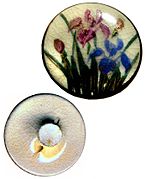-
Clam shells used for making buttons
-
Hand-painted Satsuma ware self-shank button
-
Wedgwood button with Boulton cut steels, depicting a mermaid & family, England, c. 1760. Diameter just over 32 mm (11⁄4")
-
Thread Covered buttons
Button
 From Wikipedia - Reading time: 15 min
From Wikipedia - Reading time: 15 min
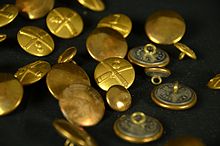

A button is a fastener that joins two pieces of fabric together by slipping through a loop or by sliding through a buttonhole.
In modern clothing and fashion design, buttons are commonly made of plastic but also may be made of metal, wood, or seashell. Buttons can also be used on containers such as wallets and bags. Buttons may be sewn onto garments and similar items exclusively for purposes of ornamentation. In the applied arts and craft, a button can be an example of folk art, studio craft, or even a miniature work of art. In archaeology, a button can be a significant artifact.
History
[edit]
Buttons and button-like objects used as ornaments or seals rather than fasteners have been discovered in the Indus Valley civilization during its Kot Diji phase (c. 2800–2600 BC).[1] Buttons as apparel have been found at sites of the Catacomb culture, Russia (2500-1950 BC), at the Tomb of the Eagles, Scotland (2200-1800 BC),[2][3][4] and at Bronze Age sites in China (c. 2000–1500 BC) and Ancient Rome.
Buttons made from seashell were used by the Indus Valley Civilization for ornamental purposes by 2000 BC.[5] Some buttons were carved into geometric shapes and were pierced so that they could be attached to clothing with thread.[5] Ian McNeil (1990) holds that "the button was originally used more as an ornament than as a fastening, the earliest known being found at Mohenjo-daro in the Indus Valley. It is made of a curved shell and is about 5000 years old."[6]
Egypt's Eighteenth Dynasty left behind ornate wig covers, fabricated through sewing buttons formed of precious metals onto strips of backing material.[7]
Leatherwork from the Roman Empire incorporates some of the first buttonholes, with the legionary's loculus closed through the insertion of a metallic buckle, or button into a leather slit. A similar mechanism would later feature in early medieval footwear.[8] Buttons appeared as a means to close cuffs in the Byzantine Empire and to fasten the necks of Egyptian tunics by no later than the 5th century.[9]
As containers
[edit]Since at least the seventeenth century, when box-like metal buttons were constructed especially for the purpose,[10] buttons have been one of the items in which drug smugglers have attempted to hide and transport illegal substances. At least one modern smuggler has tried to use this method.[11]
Also making use of the storage possibilities of metal buttons, during the World Wars, British and U.S. military locket buttons were made, containing miniature working compasses.[12]
Materials and manufacture
[edit]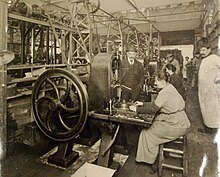
Because buttons have been manufactured from almost every possible material, both natural and synthetic, and combinations of both, the history of the material composition of buttons reflects the timeline of materials technology.
Buttons can be individually crafted by artisans, craftspeople or artists from raw materials or found objects (for example fossils), or a combination of both. Alternatively, they can be the product of low-tech cottage industry or be mass-produced in high-tech factories. Buttons made by artists are art objects, known to button collectors as "studio buttons" (or simply "studios", from studio craft).[13]
In 1918, the US government made an extensive survey of the international button market, which listed buttons made of vegetable ivory, metal, glass, galalith, silk, linen, cotton-covered crochet, lead, snap fasteners, enamel, rubber, buckhorn, wood, horn, bone, leather, paper, pressed cardboard, mother-of-pearl, celluloid, porcelain, composition, tin, zinc, xylonite, stone, cloth-covered wooden forms, and papier-mâché. Vegetable ivory was said to be the most popular for suits and shirts, and papier-mâché far and away the commonest sort of shoe button.[14]
Nowadays, hard plastic, seashell, metals, and wood are the most common materials used in button-making; the others tending to be used only in premium or antique apparel, or found in collections.
Over 60% of the world's button supply comes from Qiaotou, Yongjia County, China.[15][16]
Decoration and coating techniques
[edit]Historically, fashions in buttons have also reflected trends in applied aesthetics and the applied visual arts, with buttonmakers using techniques from jewellery making, ceramics, sculpture, painting, printmaking, metalworking, weaving and others. The following are just a few of the construction and decoration techniques that have been used in button-making:
Styles of attachment
[edit]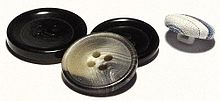
- Flat or sew-through buttons have holes through which thread is sewn to attach the button.[24] Flat buttons may be attached by sewing machine rather than by hand and may be used with heavy fabrics by working a thread shank to extend the height of the button above the fabric.

- Shank buttons have a hollow protrusion on the back through which thread is sewn to attach the button.[25] Button shanks may be made from a separate piece of the same or a different substance as the button itself, and added to the back of the button, or be carved or moulded directly onto the back of the button, in which latter case the button is referred to by collectors as having a 'self-shank'.
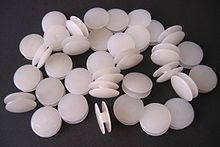
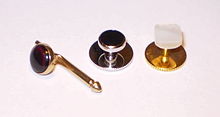
- Stud buttons (also push-through buttons or just studs) are composed from an actual button, connected to a second, button-like element by a narrow metal or plastic bar. Pushed through two opposing holes within what is meant to be kept together, the actual button and its counterpart press it together, keeping it joined. Popular examples of such buttons are shirt studs and cufflinks.
- Snap fasteners (also pressure buttons or press studs) are metal (usually brass) round discs pinched through the fabric. They are often found on clothing, in particular on denim pieces such as pants and jackets. They are more securely fastened to the material. As they rely on a metal rivet attached securely to the fabric, pressure buttons are difficult to remove without compromising the fabric's integrity. They are made of two couples: the male stud couple and the female stud couple. Each couple has one front (or top) and rear (or bottom) side (the fabric goes in the middle).

- Toggles are stick-like, with a cord attached at the center. They are passed endways through a hole and then rotated sideways.
- Magnetic buttons, as the name implies, are buttons that attach to each other by being magnetic.[26] The buttons can be attached either by sewing or snapping them into the fabric.
Fabric buttons
[edit]- Covered buttons are fabric-covered forms with a separate back piece that secures the fabric over the knob.
- Mandarin buttons or frogs are knobs made of intricately knotted strings. Mandarin buttons are a key element in Mandarin dress (Qi Pao and cheongsam in Chinese), where they are closed with loops. Pairs of mandarin buttons worn as cuff links are called silk knots.
- Worked or cloth buttons are created by embroidering or crocheting tight stitches (usually with linen thread) over a knob or ring called a form. Dorset buttons, handmade from the 17th century to 1750, and Death head buttons are of this type.
Button sizes
[edit]The size of the button depends on its use. Shirt buttons are generally small, and spaced close together, whereas coat buttons are larger and spaced further apart. Buttons are commonly measured in lignes (also called lines and abbreviated L), with 40 lines equal to 1 inch.[27] For example, some standard sizes of buttons are 16 lignes (10.16 mm, standard buttons of men's shirts) and 32 lignes (20.32 mm, typical button on suit jackets).[28]
In museums and galleries
[edit]
Some museums and art galleries hold culturally, historically, politically, and/or artistically significant buttons in their collections. The Victoria and Albert Museum has many buttons,[29] particularly in its jewellery collection, as does the Smithsonian Institution.[30][31][32][33]
Hammond Turner & Sons, a button-making company in Birmingham, hosts an online museum with an image gallery and historical button-related articles,[34] including an 1852 article on button-making by Charles Dickens.[35] In the US, large button collections are on public display at the Waterbury Button Museum of Waterbury, Connecticut,[36] the Keep Homestead Museum of Monson, Massachusetts,[37] which also hosts an extensive button archive,[38] and in Gurnee, Illinois, at The Button Room.[39]
Gallery
[edit]Positioning
[edit]Classic clothing has the button on the left side for women and on the right side for men. The reasons for this are unclear, but the choice for men's clothing is usually attributed to the need to draw weapons from the left to right; the weapon would then not catch on opening of the clothing. For women's clothing the common reason given is that in times when upper-class women's clothing was quite elaborate, servants were needed for dressing, and the left placement of the buttons was more convenient for right-handed maids.[40][41][42] Some Jews reverse this, following statements in the Torah that favor dressing first on the right side, or from the Kabbalah, in which the right side denotes goodness.[43][44][45][46]
In politics
[edit]The mainly American tradition of politically significant clothing buttons appears to have begun with the first presidential inauguration of George Washington in 1789. Known to collectors as "Washington Inaugurals",[47] they were made of copper, brass or Sheffield plate, in large sizes for coats and smaller sizes for breeches.[48] Made in twenty-two patterns and hand-stamped, they are now extremely valuable cultural artifacts.
Between about 1840 and 1916, clothing buttons were used in American political campaigns, and still exist in collections today. Initially, these buttons were predominantly made of brass (though horn and rubber buttons with stamped or moulded designs also exist) and had loop shanks. Around 1860 the badge or pin-back style of construction, which replaced the shanks with long pins, probably for use on lapels and ties, began to appear.[49]
One common practice that survived until recent times on campaign buttons and badges was to include the image of George Washington with that of the candidate in question.
Some of the most famous campaign buttons are those made for Abraham Lincoln. Memorial buttons commemorating Lincoln's inaugurations and other life events, including his birth and death, were also made, and are also considered highly collectible.[50]
See also
[edit]- Koumpounophobia, fear of buttons
References
[edit]- ^ Khan, Omar (1999). "Fired steatite button". The Indus Civilization. San Francisco, USA: harrapa.com. Retrieved 11 March 2010.
- ^ "A Day in the Neolithic: A Walk Through 5,000-year-old Scotland at the Tomb of the Eagles". Senior Hiker Magazine. 2018-08-27. Archived from the original on 2024-05-19. Retrieved 2020-10-24.
- ^ Mamwell, Caroline Jane (2018). 'It Rained a Lot and Nothing Much Happened': Settlement and Society in Bronze Age Orkney. University of Edinburgh. p. 146.
- ^ Hedges, John W. (1998-04-21). Tomb of the Eagles: Death and Life in a Stone Age Tribe. New Amsterdam Books. p. 152. ISBN 978-1-4617-3268-6.
- ^ a b Hesse, Rayner W. & Hesse (Jr.), Rayner W. (2007). Jewelrymaking Through History: An Encyclopedia. Greenwood Publishing Group. 35. ISBN 0-313-33507-9.
- ^ McNeil, Ian (1990). An encyclopaedia of the history of technology. Taylor & Francis. 852. ISBN 0-415-01306-2.
- ^ Shaw, Garry J. (2008). Royal Authority in Egypt's Eighteenth Dynasty. Ann Arbor, MI: University of Michigan Press. doi:10.30861/9781407303086. ISBN 978-1-4073-0308-6.
- ^ "Viking Boot: History of York". www.historyofyork.org.uk. Retrieved 2020-11-14.
- ^ "The Westward Journeys of Buttons - AramcoWorld". www.aramcoworld.com. Retrieved 2020-11-28.
- ^ (Luscomb 2003, p. 126)
- ^ The United States Bureau of Foreign and Domestic Commerce, Paper and Stationery Trade of the World, Government Printing Office, 1918
- ^ "A look at China's "Button Town"". www.cbsnews.com. 8 October 2015.
- ^ "Chinese 'Button Town' Struggles with Success". NPR.org.
- ^ (Luscomb 2003, p. 53)
- ^ (Luscomb 2003, p. 104)
- ^ (Luscomb 2003, pp. 123–124)
- ^ Colton, Virginia, ed. (1978). Complete Guide to Sewing. Reader's Digest. p. 352. ISBN 0-89577-026-1.
- ^ Button Country (2010). "Back Types/Shanks (23-3)". GA, USA: Peach State Button Club. Archived from the original on 17 June 2010. Retrieved 11 March 2010.
- ^ US2397931A, Robert, Ellis, "Magnetic button", issued 1946-04-09
- ^ "An Easy Guide to Button Measurement and Sizing". Sun Mei Button Enterprise Co., Ltd. 2019-06-19.
- ^ "Standard Buttons", Brain Browser, Elsevier, pp. 86–90, 1990, doi:10.1016/b978-0-12-107250-6.50007-3, ISBN 978-0-12-107250-6, retrieved 2023-11-18
- ^ "Your Search Results | Search the Collections | Victoria and Albert Museum". collections.vam.ac.uk.
- ^ American Indian Buttons made with ivory, whalebone and ink Archived 2018-12-21 at the Wayback Machine at the Smithsonian National Museum of the American Indian.
- ^ Domestic button collection, circa 1935, from Washington, D.C., at the Smithsonian National Museum of American History.
- ^ Uniform buttons Archived 2011-07-23 at the Wayback Machine of the United States Postal Service at 'Arago', the Smithsonian National Postal Museum.
- ^ "Button | Smithsonian American Art Museum". americanart.si.edu.
- ^ "Hammond-Turner.com – Online Button Museum". hammond-turner.com.
- ^ "Hammond-Turner.com – Online Button Museum". hammond-turner.com.
- ^ "Mattatuck Museum | Art Exhibitions & Educational Programs in CT". Mattatuck Museum.
- ^ "Keep Homestead Museum". keephomesteadmuseum.org.
- ^ "Keep Homestead Museum - Button Collection". keephomesteadmuseum.org. Archived from the original on 2020-01-19. Retrieved 2020-04-30.
- ^ "The Button Room". Archived from the original on 2020-11-27. Retrieved 2012-02-28.
- ^ Megan Garber (March 27, 2015). "The Curious Case of Men and Women's Buttons". The Atlantic. Retrieved November 6, 2022.
On the left for the ladies and on the right for the gents
- ^ Danny Lewis (November 23, 2015). "Here's Why Men's and Women's Clothes Button on Opposite Sides". Smithsonian. Retrieved November 6, 2022.
- ^ Benjamin Radford (July 6, 2010). "Why Are Men's and Women's Buttons on Opposite Sides?". Live Science. Retrieved November 6, 2022.
- ^ Chaya Korb Hubner (1989). The Broken Magen David. p. 116.
men button right on left .. Tznius
- ^ Danna Lorch (February 13, 2019). "Why Do Hasidic Men Button Their Shirts The Wrong Way?". The Forward. Retrieved November 6, 2022.
Just like women, most Hasidic men button their jackets, shirts, and rekels (long frock coat) with the right side over the left
- ^ Madison Margolin (February 12, 2017). "In ultra-Orthodox fashion, you can tell a lot about a person by his button holdes". The Times of Israel. Retrieved November 6, 2022.
- ^ What's the Difference Between Hasidic vs. Orthodox Jews?, June 14, 2021
- ^ Cobb, J. Harold; Kirk Mitchell (Feb 2, 2005). "J. Harold Cobb's George Washington Inaugural Button Collection". USA: Kirk Mitchell. Retrieved 13 March 2010.
- ^ (Luscomb 2003, pp. 214–218)
- ^ (Luscomb 2003, pp. 33–34)
- ^ (Luscomb 2003, pp. 119–120)
Sources
[edit]- Luscomb, Sally C. (2003). The Collector's Encyclopedia of Buttons (5th ed.). Atglen, PA: Schiffer. ISBN 0-7643-1815-2. LCCN 2003101645.
Further reading
[edit]- Bunch, Bryan (2004). The History of Science and Technology. Boston, MA: Houghton Mifflin. p. 784. ISBN 978-0-618-22123-3.
- Edwards, Nina (2012) (2012). On the Button: The Significance of an Ordinary Item. London, UK: I. B. Tauris. ISBN 978-1-84885-584-7. ASIN 1848855842.
{{cite book}}: CS1 maint: numeric names: authors list (link) - Kohler, Carl (1963). A History of Costume. USA: Dover. p. 464. ISBN 978-0-486-21030-8.
- Osborne, Peggy A. (1997). Button, button : identification and price guide. Atglen, PA: Schiffer. p. 167. ISBN 0-7643-0082-2. LCCN 92063104.
- Peacock, Primrose (1978). Discovering old buttons. Discovering series; no. 213. Rosemary Godsell (illus.). Aylesbury, UK: Shire Publications. p. 76. ISBN 0-85263-445-5.
- Wisniewski, Debra J. (1997). Antique & collectible buttons : identification & values. Charley Lynch. Paducah, KY: Collector Books. p. 168. ISBN 0-89145-711-9. LCCN 97122120.
 KSF
KSF
